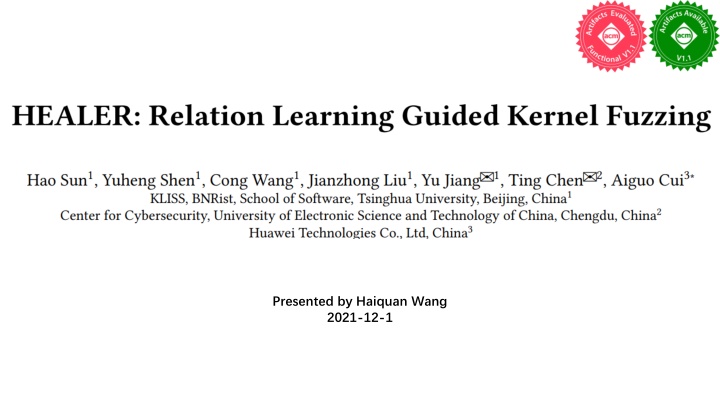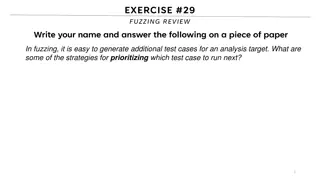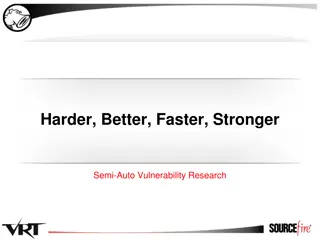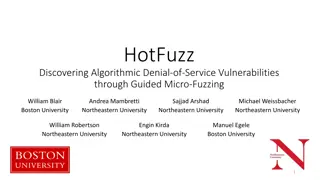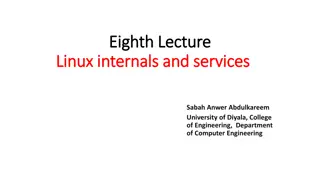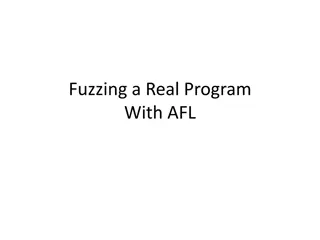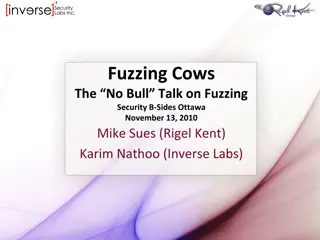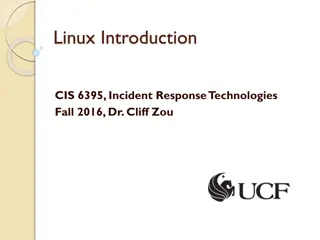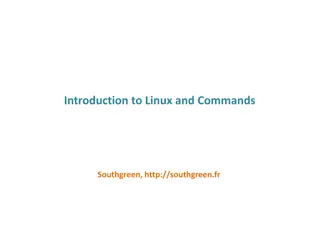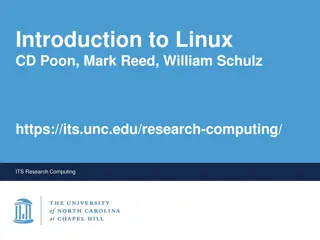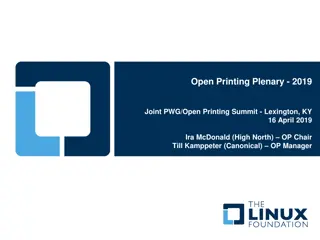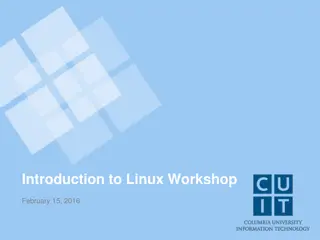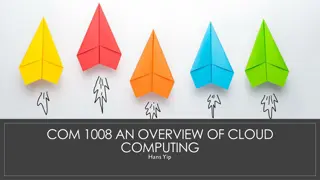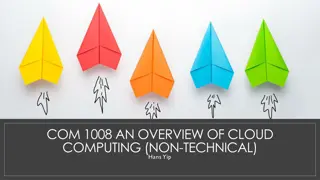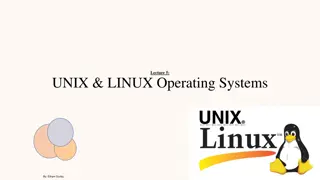Automatic Testing of Linux Kernel Using Fuzzing
Linux kernel development is rapid but prone to bugs. This paper explores automating testing using fuzzing, feeding random inputs until crashes to detect and report issues efficiently.
Download Presentation

Please find below an Image/Link to download the presentation.
The content on the website is provided AS IS for your information and personal use only. It may not be sold, licensed, or shared on other websites without obtaining consent from the author.If you encounter any issues during the download, it is possible that the publisher has removed the file from their server.
You are allowed to download the files provided on this website for personal or commercial use, subject to the condition that they are used lawfully. All files are the property of their respective owners.
The content on the website is provided AS IS for your information and personal use only. It may not be sold, licensed, or shared on other websites without obtaining consent from the author.
E N D
Presentation Transcript
Presented by Haiquan Wang 2021-12-1
Background Introduction Motivation Observation Related Work Design Evaluation Outline 2
Background Linux kernel is developing rapidly for supporting more features 3
Background Linux kernel is hard to be free of bugs 4
Background Handwrite Feed into It s difficult for handwritten test suites to keep up with rapid increase of the kernel s size and complexity 5
Background Is there any way to test Linux kernel automatically? Fuzzing! 6
Introduction Fuzzing Fuzzing feeding in random inputs until the program crashes 7
Introduction Fuzzing No Execute program Generate Input Crash? Yes Report! 8
Introduction Coverage Guided Fuzzing Select Input Mutation Corpus Description Interesting Path Random Input Saver Program Coverage Feedback 9
Introduction Kernel Fuzzing Fuzzing feeding in random inputs until the kernel crashes How do we generate inputs How do we execute the kernel How do we inject inputs How do we detect crashes How do we automate the process 10
Introduction Kernel Fuzzing Fuzzing feeding in random inputs until the kernel crashes How do we generate inputs How do we execute the kernel How do we inject inputs How do we detect crashes How do we automate the process What the paper focus on 11
Introduction Kernel Fuzzing What is kernel s inputs 12
Introduction Kernel Fuzzing Kernel inputs: syscalls Userspace The system call interface fork() wait() exit() socket() Kernel Hardware 13
Introduction Coverage Guided Fuzzing Select Input Mutation Corpus Description Interesting Path Random Input Saver Program Coverage Feedback 14
Introduction Syscall Description Language Modeling dependencies between syscalls Resource fd[int32]: 0xffffffffffffffff, AT_FDCWD, 1000000 Resource sock[fd] Resource sock_in[sock] Identifier name inheritance type Socket$inet(domain const[AF_INET], type flags[socket_type], proto int32) sock_in Accept$inet(fd sock_in, peer ptr[out, sockaddr_in], peerlen ptr[inout, len[peer, int32]]) sock_in Bind$inet(fd sock_in, addr ptr[in, sockaddr_in], addrlen len[addr]) Listen(fd sock, backlog int32) Optional Arguments System Call name Generates and mutates testcases based on Syzlang Define the search space 15
Problem Countless Call combinations Around 400 syscalls in Linux 4000+ specialized syscalls in Syzlang description Length of generated call sequence is 8~32 Possible number of combinations is ??=8 Most call sequences are invalid and equivalent 4000 ? 32 = 1080 We need better strategy to choose call combination, rather than random 16
Related Work Syzkallers Choice Table Each item records the probability that a system call should be invoked before another system call Choose next call based on the probability Example: for system call Ci Cj, the Pijis calculated by ???= ???? note: ????and ????are both normalized to 10 ~ 1000 ????is calculated by static algorithm: specific common types between two system calls ????is calculated by dynamic algorithm: the more adjacent calls corresponding to (Ci , Cj) ???? ???? For instance, [Ci, Cj, Ck] is the system call sequence in corpus, but Cimay not have impact on the execution path of Cj Too Empirical 17
Observation Influence Relation sock_fd = socket(AF_INET, SOCK_STREAM, 0) Former calls setup related kernel states Create socket inside the kernel The latter calls can be influenced by those states bind(sock_fd, &addr, sizeof(addr)) Execution path of the latter call changed due to the internal kernel state modified by the former call Bind address to the socket listen(sock_fd, ) Insert more system calls that have influence relations before the target system call so that we can trigger different kernel states and allow each system call to enter deep execution paths Mark socket accept(sock_fd, &peer_addr, &size) The number of invalid test cases and the size of the search space can be reduced significantly by taking relations between system calls into consideration 18
Our Idea Guide Kernel Fuzzing with Relation Learning Learn the influence relations dynamically, iteratively Guide generation and mutation with learned relations Increase the quality of inputs, speedup the fuzzing process 19
Design definition Relation: A system call Ci has an influence on another system call Cj if the execution of Ci can influence the execution path of Cj by modifying the kernel s internal state. Relation is about influence of execution path The reason behind relation is kernel state Rij= 1, if Cihas relation with Cj 20
Design Relation Learning Static Learning Dynamic Learning Step 1: Minimization Step 2: Update Relation Table Guided Generation and Mutation 21
Design Static Learning Purpose: Learn the relations expressible by Syzlang description Idea: The producer syscall of one resource can influence the consumer syscall of that resource Steps: two simple rules: The return type of Ciis a resource type r0 with an outward data flow direction At least one of Cj s parameter is a resource type r0 or resource type r1that is compatible with r0with an in ward data flow direction Resource sock_in[sock] Socket$inet(domain const[AF_INET], type flags[socket_type], proto int32) sock_in Listen(fd sock, backlog int32) 22
Design Dynamic Learning Step 1: Minimization Purpose: Only analyze calls that contribute to new coverage. Idea: Remove one call as long as the coverage keeps the same Steps: For sequence P and code coverage of each call in P: Extract the subsequence p for call Ci that has not yet been included in the other minimal sequences Remove each call C before Ciin p If coverage keeps same, commit the change Example For [call0, call1, call2, call3], with [cov0, cov1, cov2, cov3] remove call1, execute other calls cov3has no change Commit remove call1 23
Design Dynamic Learning Step 2: Update Relation Table Purpose: Learn the relations not expressible by Syzlang description Idea: The relation is all about execution path, observe the coverage change Steps: For each adjacent call pair (Ci, Cj) of the minimized sequence P: Remove Ci, observe the coverage change of Cj If the coverage of Cjchanged, Cimust have influence relation with Cj, since they re adjacent Learn relations iteratively 24
Design Guided Generation and Mutation Purpose: Generate high quality inputs Idea: Use learned relations to select call that matters Steps: For call sequence [Ci, Cj, Ck] choose Cxas next call: Prefer to randomly choosing next call at the beginning Find candidate calls that can be influenced by Ci, Cj, Ck, count number of calls that influence the candidate as weight(Rix+Rjx+Rkx) Make a random selection based on the weights: a higher weight corresponds to a higher probability of being selected Example: For sequence [socket, bind] The candidates are [listen: 2, accept: 1] `listen` has higher priority to be chosen 25
Design Revisit the fuzzing loop Relation Table Select Input Mutator Corpus Description Refine Random Input Refine Relation Learning Program Coverage Feedback 26
Implementation Shared fuzzer states Fuzzers run in host Only executor runs in VM Shmem communication QEMU ivshm 27
Evaluation Setup 16 core CPU 32 GB memory Linux-5.11, Linux-5.4, Linux-4.19 Each set of experiments is repeated 10 times Each experiment is executed over 24h Healer-: Healer without relation learning 28
Evaluation Q1: how many new bugs can healer find? HEALER find 33 previously unknown vulnerabilities which are confirmed by corresponding maintainers. 29
Evaluation Q2: can healer find more bugs than Syzkaller, Moonshine, Healer-? 15 vulnerabilities found by HEALER while missed by Syzkaller, Moonshine and HEALER- Fuzzing System Vulnerability Found Healer 32 Syzkaller 20 Moonshine 17 Healer- 10 Healer only misses 3 vulnerabilities 30
Evaluation Q3: can relation learning work as expected? The influence relations is overall sparse and locally dense 31
Evaluation Q3: can relation learning work as expected? 32
THANKS! 33
